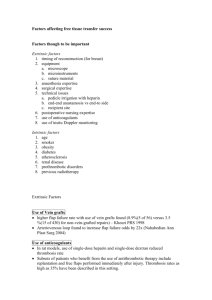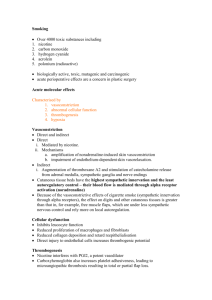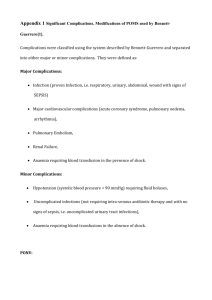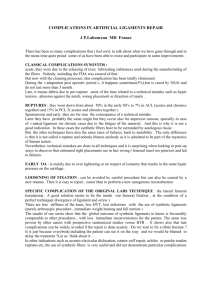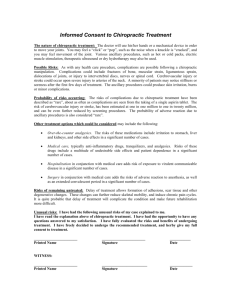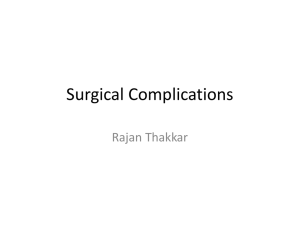Obesity
advertisement
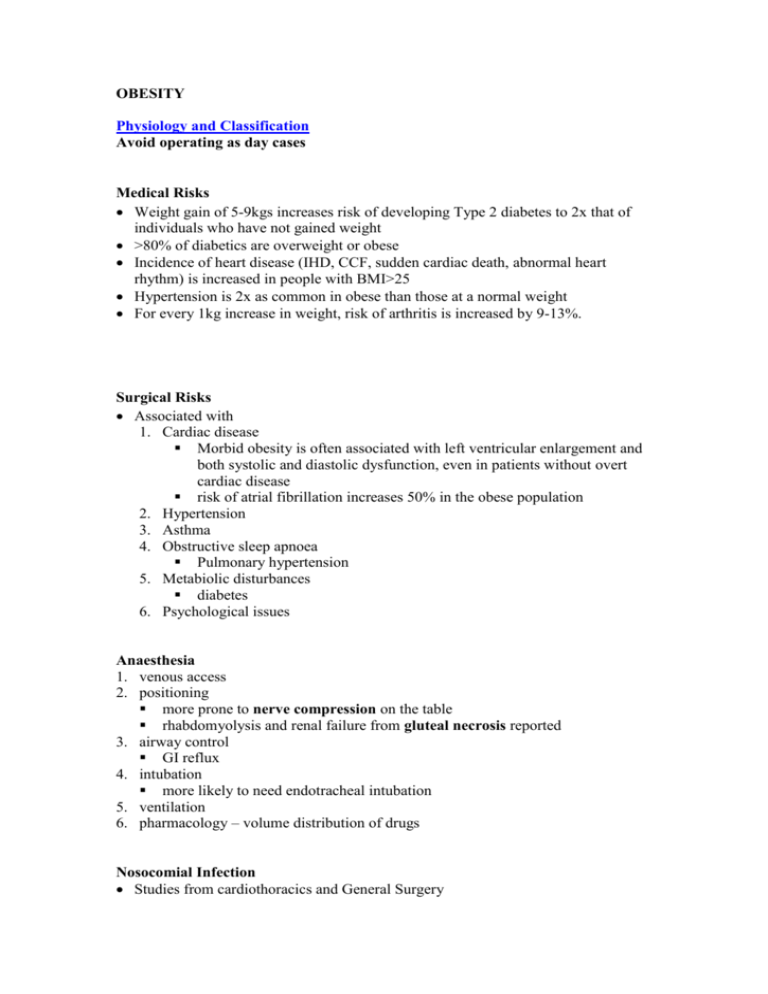
OBESITY Physiology and Classification Avoid operating as day cases Medical Risks Weight gain of 5-9kgs increases risk of developing Type 2 diabetes to 2x that of individuals who have not gained weight >80% of diabetics are overweight or obese Incidence of heart disease (IHD, CCF, sudden cardiac death, abnormal heart rhythm) is increased in people with BMI>25 Hypertension is 2x as common in obese than those at a normal weight For every 1kg increase in weight, risk of arthritis is increased by 9-13%. Surgical Risks Associated with 1. Cardiac disease Morbid obesity is often associated with left ventricular enlargement and both systolic and diastolic dysfunction, even in patients without overt cardiac disease risk of atrial fibrillation increases 50% in the obese population 2. Hypertension 3. Asthma 4. Obstructive sleep apnoea Pulmonary hypertension 5. Metabiolic disturbances diabetes 6. Psychological issues Anaesthesia 1. venous access 2. positioning more prone to nerve compression on the table rhabdomyolysis and renal failure from gluteal necrosis reported 3. airway control GI reflux 4. intubation more likely to need endotracheal intubation 5. ventilation 6. pharmacology – volume distribution of drugs Nosocomial Infection Studies from cardiothoracics and General Surgery 3x increase risk in obese 4x increase risk in severe obese Mostly due to increase in surgical site infection (2-3x RR) Mechanisms 1. decreased oxygen tension 2. immune impairment 3. tension and secondary ischemia along long suture lines. 4. chronic skin infections ie Candida Also increase risk of pneumonia and UTI Poor wound healing Due to 1. infection 2. wound tension 3. reduced oxygen tension Pulmonary Restrictive lung pattern Increased atelactasis Gastric Delayed gastric emptying – in general have higher preoperative gastric volumes Reflux Venous Thromboembolism Mechanisms 1. increased intra-abdominal pressure 2. venous stasis 3. hypercoagulable state • higher levels of factor VIII and factor IX, but not of fibrinogen ) • decreased circulating antithrombin III (AT III) and decreased fibrinolytic activity 4. Poor mobility estimated incidence of DVT and PE in patients receiving perioperative prophylaxis ranges from 0.2% to 2.4 Relative risk (obese vs nonobese) Am J Med 2004 • DVT – 2.5x • PE – 2.2x In overweight/obese (BMI>25) women on OCP – 10x risk of DVT (Thromb Haemost 2003) Blood Loss BMI correlated with increased surgical blood loss Risks in Plastic Surgery Breast Reconstruction Paige, Bostwick PRS 1998 Pedicled TRAM, retrospective n=257 Obesity significantly associated with 1. Donor site complications 2. Fat necrosis 3. Partial flap loss 4. Breast mound infection Chang DW; Effect of Obesity on Flap and Donor site complications in Free TRAM PRS 2000 Apr Free TRAM, retrospective n=939 flaps (718 patients) Flap complications: Obese(BMI>30) vs normal weight o overall flap complications (39.1 vs 20.4%), o total flap loss (3.2 versus 0%) o flap seroma (10.9 versus 3.2%) o mastectomy flap necrosis (21.9 versus 6.6%). Flap complications: Overweight(BMI 25-30) vs normal weight o overall flap complications (27.8 versus 20.4%) o total flap loss (1.9 versus 0%) o flap hematoma (0 versus 3.2%) o mastectomy flap necrosis (15.1 versus 6.6%) Donor complications: Obese vs normal weight o overall donor-site complications (23.4 versus 11.1%) o infection (4.7 versus 0.5%) o seroma (9.4 versus 0.9%) o hernia (6.3 versus 1.6%). Donor complications: Overweight vs normal weight o overall donor-site complications (19.8 versus 11.1) o infection (2.4 versus 0.5%) o bulge (5.2 versus 1.8%) o hernia (4.3 versus 1.6%) Alderman AK, Wilkins EG, Kim HM, Lowery JC. Complications in postmastectomy breast reconstruction: two-year results of the Michigan Breast Reconstruction Outcome Study. Plast Reconstr Surg. 2002 Jun prospective cohort design, women undergoing first-time, immediate or delayed breast reconstruction 326 patients from 12 centres increasing body mass index was found to be associated with increasing odds of a complication, with an odds ratio of 1.08 for total complications and 1.12 for major complications. Munhoz AM; Outcome analysis of breast-conservation surgery and immediate latissimus dorsi flap reconstruction in patients with T1 to T2 breast cancer. Plast Reconstr Surg. 2005 Sep BMI>30 associated with increased donor site complications; especially seroma (a 5.2-fold increase) Ducic I, Spear SL; Safety and risk factors for breast reconstruction with pedicled transverse rectus abdominis musculocutaneous flaps: a 10-year analysis. Ann Plast Surg. 2005 Dec Retrospective study of 224 pedicled TRAM recons Obesity (BMI>30) related to Overall donor site complications (OR 2.6) Overall flap complications (OR 2.6) Multiple flap complications (OR 6.7) TRAM delayed healing (OR 4.2) Minor flap necrosis (OR 5.1) Wang HT, Hartzell T, Olbrich KC, Erdmann D, Georgiade GS; Delay of transverse rectus abdominis myocutaneous flap reconstruction improves flap reliability in the obese patient. Plast Reconstr Surg. 2005 Aug; By delaying the pedicled TRAM, flap related complications did not show an increase with increasing BMI However non-flap-related complications, such as deep venous thrombosis/pulmonary embolism; donor site morbidity , was 8% for those with a body mass index of less than 30 vs 32% for those with an index greater than 30. Summary 1. increased risk of flap failure and flap complications - seroma 2. increased risk of mastectomy flap complications 3. increased risk of donor site complications especially seroma, wound healing, and infection Breast Reduction Only 20% of women undergoing reduction mammoplasty are of normal weight Strombeck 1964 systemic and local complications 4.4% for the nonobese 13.5% for those > 10 kg overweight. Zubowski (PRS 2000; retrospective n=395) Major local complications (skin loss, nipple loss, abscess, and hematoma ) 6.2% for the nonobese 9.2% for those > 10 kg overweight. Complications correlated with increasing weight of reduction Platt (Ann Plast Surg 2003 prospective n=30) BMI > 26.3, 33% wound breakdown rate BMI < 26.3, 10% wound breakdown rate; P < 0.05 Wagner (PRS 2005, retrospective n=186) no increase in the complication rate in the obese patients O’Grady (PRS 2005, retrospective n=133) BMI not associated with nipple necrosis, hematoma formation, fat necrosis, cyst formation, nipple sensation, or hypertrophic scarring Higher BMI predicted a delayed healing, wound dehiscence, and infection. (relative risk 1.2x) Summary increased risk (1.5-3x) of: 1. delayed healing 2. wound dehiscence 3. infection Stronger correlation with size of reduction Abdominoplasty Vastine (Ann Plast Surg 1999) Retrospective study, n=90 80% of obese patients had complications compared with the borderline and nonobese patients, who had complication rates of 33% and 32.5% respectively Previous gastric bypass surgery had no significant effect on the incidence of postabdominoplasty complications. van Uchelen JH, Werker PM, Kon M. Complications of abdominoplasty in 86 patients. Plast Reconstr Surg. 2001 Jun Increased incidence of wound complications Kim J, Stevenson TR. Abdominoplasty, liposuction of the flanks, and obesity: analyzing risk factors for seroma formation. Plast Reconstr Surg. 2006 Mar; atients who are overweight or obese present a statistically significantly higher risk for developing seromas postoperatively than patients of normal weight. Liposuction of the flanks in concert with abdominoplasty did not increase the risk of seroma formation. Summary Increased risk of infection, delayed wound healing and seroma Body contouring Taylor (Obese Surg 2004) Retrospective study, n=30 post massive weight loss Overall morbidity 42% 20% wound breakdown 17% seroma 1 patient died from PE Challenging surgery requiring individualized approaches with intensive follow-up. Sanger (Ann Plast Surg 2006) Retrospective study, n=26 post massive weight loss 27% wound complications(seromas, hematoma, infection, and fat necrosis) increase in wound complications attributed to the inherent complications seen with obese patients. Summary Only case series in the literature High complication rates 30-40%
